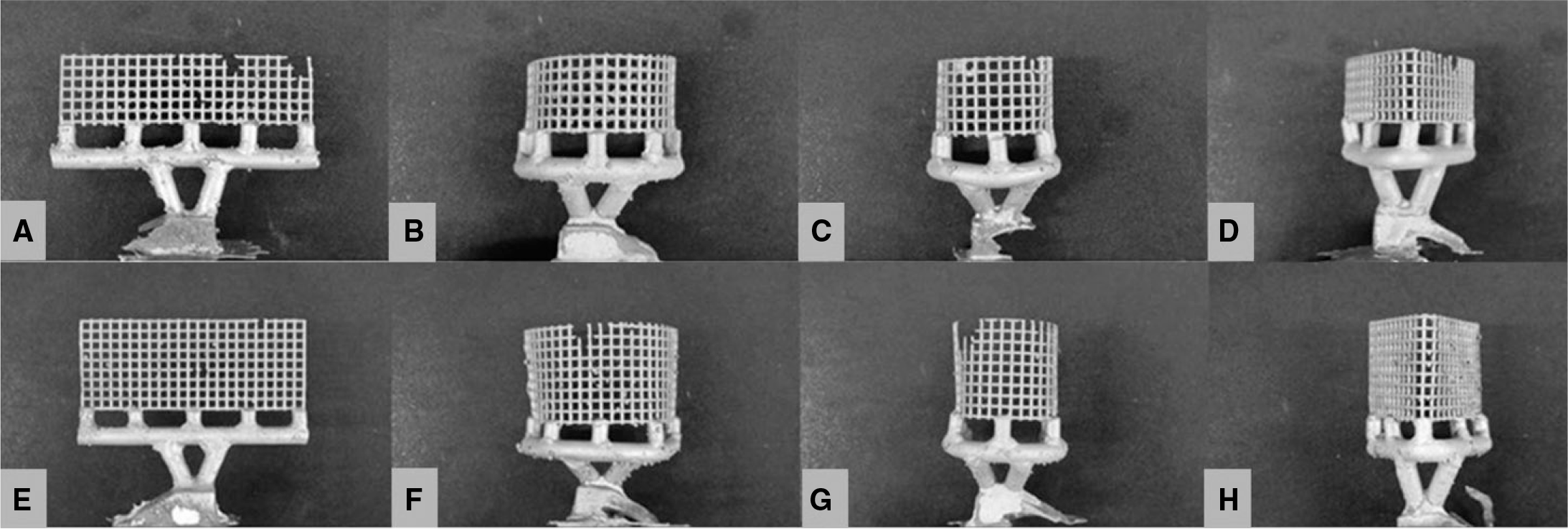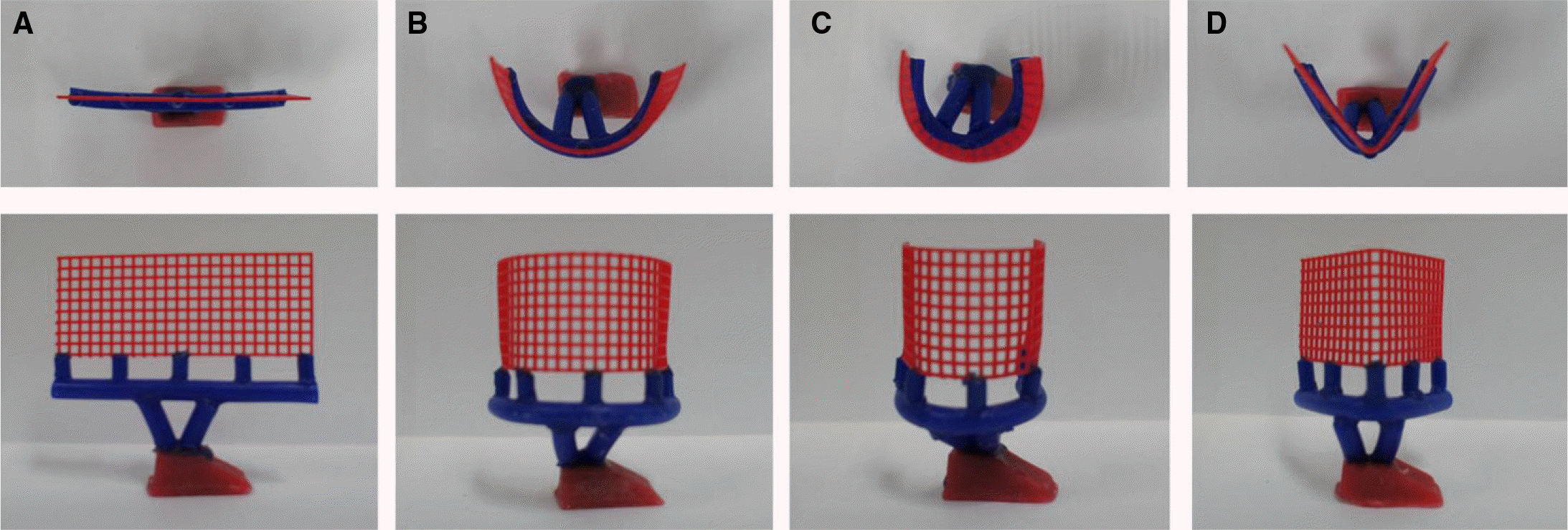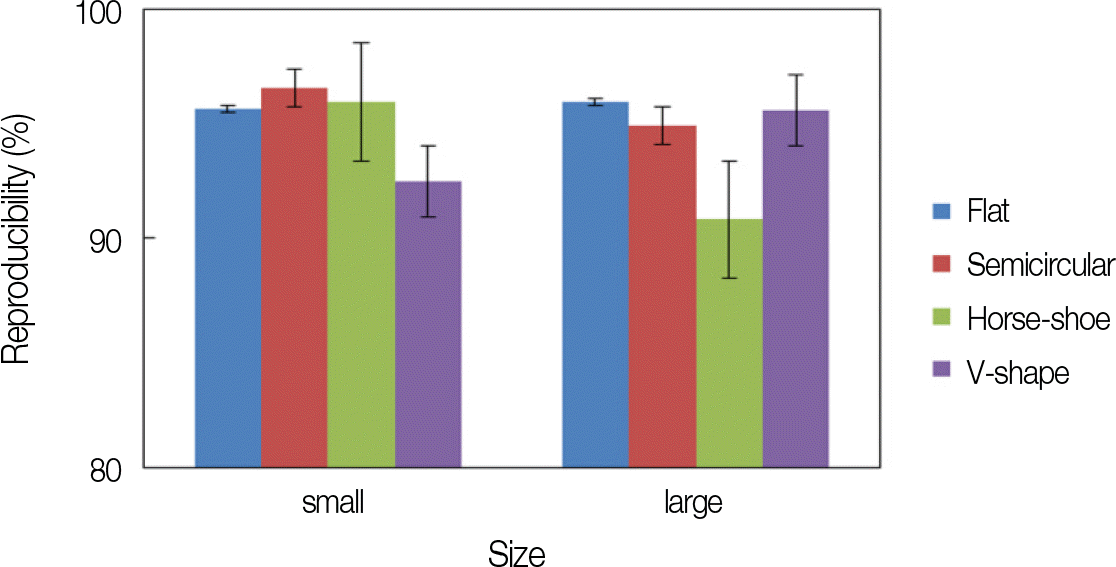Abstract
Purpose
The purpose of this study was to investigate the effect of geometrically different wax pattern shapes and sizes on the castability of Grade2 Cp-Ti (commercially pure titanium).
Materials and methods
Total of 40 mesh wax pattern (61 mm × 24 mm, 207 grids), (61 mm × 17 mm, 138 grids) was cast in this experiment. Depending on the geometrical shape of the wax pattern, 8 groups was organized; Flat, Semicircular, Horse-shoe and V-shape, each consisting 5 samples. Runner-bar sprue was used in all patterns. The number of completely cast grid in wax pattern served as a measure for the castability of comercially pure titanium.
Results
The mean value of square count in each group was as followed; 133.20 squares in group SS (96.52%), 132.40 squares in group SH (95.94%), 132.00 squares in group SF (95.65%), 127.60 squares in SV (91.43%), 198.60 squares in group LF (95.94%), 197.80 squares in group LV (95.56%), 196.40 squares in group LS (94.88%), and 188.00 squares in group LH (90.82%).
Conclusion
Within the limitations of this study the results indicate that there were no sttistically significant difference in castability of titanium regarding wax pattern shape (P>.05). However, Small size wax patterns were showing the noticeable castability more than Large size pattern. (J Korean Acad Prosthodont 2013;51:261-8)
Go to : 
REFERENCES
1.Hansson HA., Albrektsson T., Bra�nemark PI. Structural aspects of the interface between tissue and titanium implants. J Prosthet Dent. 1983. 50:108–13.

2.Parr GR., Gardner LK., Toth RW. Titanium: the mystery metal of implant dentistry. Dental materials aspects. J Prosthet Dent. 1985. 54:410–4.

3.Albrektsson T., Zarb G., Worthington P., Eriksson AR. The longterm efficacy of currently used dental implants: a review and proposed criteria of success. Int J Oral Maxillofac Implants. 1986. 1:11–25.
4.Bessing C., Bergman M. The castability of unalloyed titanium in three different casting machines. Swed Dent J. 1992. 16:109–13.
5.Mori T., Jean-Louis M., Yabugami M., Togaya T. The effect of investment type on the fit of cast titanium crowns. Aust Dent J. 1994. 39:348–52.

6.Okabe T., Hero H. The use of titanium in dentistry. Cell Mater. 1995. 87:211–30.
7.Cho LR., Yi YJ., Park CJ. The effects of spure and invents on the casting accuracy and porosity of Ti-Ni castings. J Korean Acad Prosthodont. 2003. 41:342–50.
8.Park JK., Jeong CM., Jeon YC. The effect of sprue design on the marginal reproducibility of cast titanium crowns. J Korean Acad Prosthodont. 2002. 40:344–51.
9.Kim ST., Vang MS., Yang HS., Park SW., Park HO., Lim HP. The effect of casting machine and investment on the castability of titanium. J Korean Acad Prosthodont. 2007. 45:522–33.
10.Burnett CA., Maguire H. Sprue design in removable partial denture casting. J Dent. 1996. 24:99–103.

11.Chai TI., Stein RS. Porosity and accuracy of multiple-unit titanium castings. J Prosthet Dent. 1995. 73:534–41.

12.Chan D., Guillory V., Blackman R., Chung KH. The effects of sprue design on the roughness and porosity of titanium castings. J Prosthet Dent. 1997. 78:400–4.

13.Takahashi J., Zhang JZ., Okazaki M. Effect of casting methods on castability of pure titanium. Dent Mater J. 1993. 12:245–52.

14.Kusakari H., Ozaki Y., Hoshino H. Cast titanium crown-for a better fitness and less porosity [in Janpanes]. Quintessence. Dent Technol. 1998. 23:17–23.
15.DeWald E. The relationship of pattern position to the flow of gold and casting completeness. J Prosthet Dent. 1979. 41:531–4.

16.Blackman R., Barghi N., Tran C. Dimensional changes in casting titanium removable partial denture frameworks. J Prosthet Dent. 1991. 65:309–15.

17.Bridgeman JT., Marker VA., Hummel SK., Benson BW., Pace LL. Comparison of titanium and cobalt-chromium removable partial denture clasps. J Prosthet Dent. 1997. 78:187–93.
18.Watanabe K., Okawa S., Miyakawa O., Nakano S., Honma H., Shiokawa N., Kobayashi M. Relationship between titanium flow and casting contamination caused by mold materials. J Dent Mater. 1992. 11:662–71.
19.Watanabe I., Woldu M., Watanabe K., Okabe T. Effect of casting method on castability of titanium and dental alloys. J Mater Sci Mater Med. 2000. 11:547–53.
20.Baltag I., Watanabe K., Miyakawa O. Internal porosity of cast titanium removable partial dentures: influence of sprue direction and diameter on porosity in simplified circumferential clasps. Dent Mater. 2005. 21:530–7.

21.Her� H., Syverud M., Waarli M. Mold filling and porosity in castings of titanium. Dent Mater. 1993. 9:15–8.
22.Syverud M., Her� H. Mold filling of Ti castings using investments with different gas permeability. Dent Mater. 1995. 11:14–8.

23.Heo SM., Jeon YC., Jeong CM., Lim JS., Jeong HC. The effect of sprue design on the internal porosity of titanium castings. J Korean Acad Prosthodont. 2006. 44:147–56.
24.Love LD. Sprue design to minimize casting defects in base-metal castings. Quintessence Dent Technol. 1987. 11:195–7.
25.Matin KA., Manderson RD. The influence of sprue design on cobalt chromium alloy casting defects. J Dent. 1984. 12:175–82.

26.Wu M., Wagner I., Sahm PR., Augthun M. Numerical simulation of the casting process of titanium removable partial denture frameworks. J Mater Sci Mater Med. 2002. 13:301–6.
27.Wu M., Augthun M., Wagner I., Sahm PR., Spiekermann H. Numerical simulation of the casting process of titanium tooth crowns and bridges. J Mater Sci Mater Med. 2001. 12:485–90.
28.Watanabe K. Merit and demerit of runner bar for crown-bridge titanium casting-sink vortex causes internal defects [in Japanese]. Quintessence Dent Technol. 1999. 24:19–25.
29.Chan DC., Blackman R., Kaiser DA., Chung K. The effect of sprue design on the marginal accuracy of titanium castings. J Oral Rehabil. 1998. 25:424–9.

30.Ryge G., Kozak SF., Fairhurst CW. Porosities in dental gold castings. J Am Dent Assoc. 1957. 54:746–54.

31.Blackman R., Barghi N., Tran C. Dimensional changes in casting titanium removable partial denture frameworks. J Prosthet Dent. 1991. 65:309–15.

32.Andersson M., Bergman B., Bessing C., Ericson G., Lundquist P., Nilson H. Clinical results with titanium crowns fabricated with machine duplication and spark erosion. Acta Odontol Scand. 1989. 47:279–86.

33.Hruska AR., Borelli P. Quality criteria for pure titanium casting, laboratory soldering, intraoral welding, and a device to aid in making uncontaminated castings. J Prosthet Dent. 1991. 66:561–5.

34.Syverud M., Okabe T., Her� H. Casting of Ti-6Al-4V alloy compared with pure Ti in an Ar-arc casting machine. Eur J Oral Sci. 1995. 103:327–30.
35.Watanabe K., Okawa S., Miyakawa O., Nakano S., Shiokawa N., Kobayashi M. Molten titanium flow in a mesh cavity by the flow visualization technique. Dent Mater J. 1991. 10:128–37.

36.Chung DW., Yang HS. The effect of casting machine and investment on the castability of titanium alloy. J Korean Acad Prosthodont. 2006. 44:654–64.
37.al-Mesmar HS., Morgano SM., Mark LE. Investigation of the effect of three sprue designs on the porosity and the completeness of titanium cast removable partial denture frameworks. J Prosthet Dent. 1999. 82:15–21.

38.Compagni R., Faucher RR., Yuodelis RA. Effects of sprue design, casting machine, and heat source on casting porosity. J Prosthet Dent. 1984. 52:41–5.

39.Vidovic Y., Chung HG., Mori T. Enhancement of a titanium denture frame model: mold temperature and spruing factors. Dent Mater J. 1995. 14:256–62.
40.Preston JD., Berger R. Some laboratory variables affecting cer-amo-metal alloys. Dent Clin North Am. 1977. 21:717–28.
Go to : 
 | Fig. 2.Stone block indexes used for fabricating wax patterns. A: Semicircular, B: Horse-shoe, C: V-shape. |
 | Fig. 6.Sample of casted mesh patterns. A: Small Flat, B: Small Semicircular, C: Small Horse-shoe, D: Small V-shape, E: Large Flat, F: Large Semicircular, G: Large Horse-shoe, H: Large V-shape. |
Table 1.
Experimental groups used in this study
| Pattern size | Pattern design | Code (n = 5) |
|---|---|---|
| Small (138 Grids) | Flat | SF |
| Semicircular | SS | |
| Horse-shoe | SH | |
| V-shape | SV | |
| Large (207 Grids) | Flat | LF |
| Semicircular | LS | |
| Horse-shoe | LH | |
| V-shape | LV |
Table 2.
Castability measurements of specimens




 PDF
PDF ePub
ePub Citation
Citation Print
Print






 XML Download
XML Download